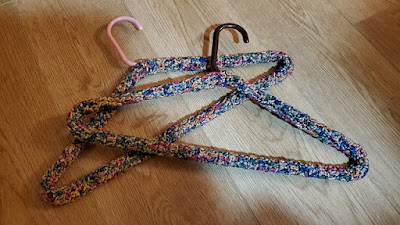This is a quick, easy, and useful knit for storing extra used plastic grocery bags, which you can reuse later as trash can liners, etc. This Sack Saver Stuffie will keep your plastic bags neatly contained and stashed away until you need them. It has a hanging loop and an opening at each end for quick access to add/remove the bags.
Using the Addi Express King Size machine (or similar size) cast on with waste yarn and work for 5 to 6 rows. Drop the waste yarn and start working in the main color (I used Red Heart Super Saver in Neon Stripes colorway as my main color). Work 60 rows in main color, then drop main color and continue working in the contrast color (I used Red Heart Super Saver in Black as my contrast color). Work in contrast color for 60 rows; do not cut yarn. Drop contrast color into center of machine and continue working in waste yarn again for 5 to 6 rows. Cast off project from machine.
Gently stretch the project, then fold the contrast color side of the tube inside of the main color side of the tube so the cast on/cast off edges are aligned. Using a 5mm crochet hook, join the contrast color edge stitches to the main color stitches, alternating one stitch from each side until all stitches are secured all the way around. Pull the short tail from the start of the main color section through the last loop on your crochet hook to secure. Remove waste yarn.
Gently stretch the project a little more. Position the contrast color working yarn (still attached to its skein) to continue working around the edge you just used your crochet hook to secure. Being careful to work around two strands of yarn from the project for each stitch, SC around this edge of the tube (you should have 46 SC around). Join the end of the round of SC with a sl in the 1st SC. Ch 1. Holding a large ponytail elastic against the top of the round of SC stitches you just made, SC over the ponytail elastic and into the top of the SC stitches you just worked, placing 1 SC in each SC from the previous round. Continue all the way around to secure the ponytail elastic inside the crochet stitches. Join the end of the round with a sl in the 1st SC. Don't break yarn yet.
To make the hanging loop, ch 10 and sl to join the chain in the same st right beside where you started chaining. Sl into the next st over on top edge of tube, then turn your work and SC back over the 10 chains to make the hanging loop sturdier. Sl to the next st over from where you started making the hanging loop. Finish off with a secure knot. Hide yarn tails in between the knitted layers.
Turn the work so the folded/open end of the tube is facing you. Place a slipknot of the contrast color yarn on your crochet hook and (being careful to always work into two strands at the folded end of the knitted tube) join this yarn to the folded edge. Ch 1 and evenly work 46 SC around the folded edge. At the end of the round join with a sl to the 1st SC. Ch 1 and (as before) hold a large ponytail elastic against the top of the round of SC stitches you just made and SC over the ponytail elastic and into the top of the SC stitches you just worked. Place 1 SC in each SC from the previous round. Continue all the way around to secure the ponytail elastic inside the crochet stitches. Join the end of the round with a sl in the 1st SC. Finish off with a secure knot. Hide yarn tails in between the knitted layers.
All done! This Sack Saver Stuffie will easily store dozens of used plastic grocery bags.





























